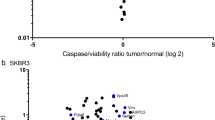Summary
Monoclonal antibodies were raised against purified human milk fat globule membranes. The binding of three of these (Mam-3, HMFG 1, and HMFG 2) to fixed histological sections of 100 primary breast carcinomas has been investigated. Tissue specificity was investigated by testing the binding of the antibodies to carcinomas from other organs and to benign proliferative breast lesions.
In breast tissue, antigens were found only in the epithelial cells, while the stromal component, myoepithelium, and any inflammatory cells present were negative. The reaction was characterized by considerable heterogeneity, both with regard to the percent of cells positive and the intensity of the reaction. No relationship was observed between binding and histological type of breast carcinoma. However, in ductal infiltrating carcinomas, a tendency towards a greater proportion of tumors that bound the antibodies was observed among the highly differentiated compared to the low differentiated carcinomas.
Data on estrogen and progesterone receptors were available in 53 and 22 of the 100 carcinomas, respectively. There were no apparent relationships between the presence of surface antigens and the menopausal status, lymph node status, or estrogen receptor status, but the tumors lacking progesterone receptor apparently lacked the antigens as well.
The presence of surface antigens probably defines a differentiation in primary breast carcinoma. Whether this differentiation is of any prognostic significance remains to be established.
Similar content being viewed by others
References
Köhler G, Milstein C: Continuous cultures of fused cells secreting antibody of predefined specificity. Nature 256: 495–497, 1975.
Hilkens J, Buijs F, Hilgers J, Hageman Ph, Sonnenberg A, Koldovsky U, Karande K, Van Hoeven RP, Feltkamp C, Van de Rijn JM: Monoclonal antibodies against human milk fat globule membranes detecting differentiation antigens of the mammary gland. Proc Biol Fluids 29: 813–816, 1981.
Taylor-Papadimitrou J, Peterson JA, Arklin J, Burchell J, Ceriani RL, Bodmer WF: Monoclonal antibodies to epithelium-specific components of the human milk fat globule membrane: production and reaction with cells in culture. Int J Cancer 28: 17–21, 1981.
Colcher D, Horan Hand P, Nuti M, Schlom J: A spectrum of monoclonal antibodies reactive with human mammary tumor cells. Proc Natl Acad Sci USA 78: 3199–3203, 1981.
Schlom J, Wunderlich D, Teramoto YA: Generation of human monoclonal antibodies reactive with human mammary carcinoma cells. Proc Natl Acad Sci USA 77: 6841–6845, 1980.
Ceriani RL, Thompson K, Peterson JA, Abraham S: Surface differentiation antigens of human mammary epithelial cells carried on the human milk fat globule. Proc Natl Acad Sci USA 74: 582–586, 1977.
Arklie J, Taylor-Papadimitrou J, Bodmer W, Egan M, Millis R: Differentiation antigens expressed by epithelial cells in the lactating breast are also detectable in breast cancer. Int J Cancer 28: 23–29, 1981.
Taylor CR: Immunoperoxidase techniques. Arch Pathol Lab Med 102: 113–121, 1978.
Bloom HJG, Richardson WW: Histological grading and prognosis in breast cancer. Br J Cancer 11: 359–377, 1957.
Sloane JP, Ormerod MG: Distribution of epithelial membrane antigen in normal and neoplastic tissues and its value in diagnostic tumor pathology. Cancer 47: 1786–1795, 1981.
Heyderman E, Steele K, Ormerod G: A new antigen on the epithelial membrane: its immunoperoxidase localisation in normal and neoplastic tissue. J Clin Path 32: 35–39, 1979.
Rasmussen BB, Rose C, Thorpe SM, Hou-Jensen K, Daehnfeldt JL, Palshof T: Histopathological characteristics and estrogen receptor content in primary breast carcinoma. Virch Arch (Pathol Anat) 390: 347–351, 1981.
Foster CS, Dinsdale EA, Edwards PAW, Neville AM: Monoclonal antibodies to the human mammary gland. Virch Arch (Pathol Anat) 394: 295–305, 1982.
Fisher ER, Gregorio RM, Fisher B, Redmond C, Vellios F, Sommers SC: The pathology of invasive breast cancer. Cancer 36: 1–85, 1975.
EORTC Breast Co-operative Group: Revision of the standards for the assessment of hormone receptors in human breast cancer, report of the second EORTC workshop, held on 16–17 March, 1979, in The Netherlands Cancer Institute. Eur J Cancer 16: 1513–1515, 1980.
Author information
Authors and Affiliations
Rights and permissions
About this article
Cite this article
Rasmussen, B.B., Hilkens, J., Hilgers, J. et al. Monoclonal antibodies applied to primary human breast carcinoma: Relationship to menopausal status, lymph node status, and steroid hormone receptor content. Breast Cancer Res Tr 2, 401–405 (1982). https://doi.org/10.1007/BF01805883
Issue Date:
DOI: https://doi.org/10.1007/BF01805883



